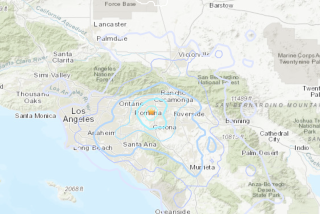Worst May Not Be Over : Quake Experts Rebut Professor’s Remarks
- Share via
WHITTIER — Earthquake experts are challenging the statements of a Whittier College professor who told a meeting of more than 600 people that Whittier has seen the worst of its earthquake days.
Dallas Rhodes, a geology professor, told a Town Hall meeting Nov. 22 in Whittier that “the amount of shaking and damage we endured here was probably as much as we’d get from the Big One” predicted to occur on the San Andreas Fault in the next 30 years.
Rhodes’ comments came during an hourlong presentation that also included remarks from community leaders and experts in building safety, finance and redevelopment.
Based on Mercalli Scale
Rhodes said in an interview that he based his statement on the Mercalli modified intensity scale, which measures physical damage and people’s responses after an earthquake.
On the Mercalli scale of 0-12, the Oct. 1 earthquake rated between a 7 and 8 in Whittier, he said. Predictions based on the Mercalli scale show that a great earthquake would result in a Mercalli rating of 6 or 7, since Whittier is about 30 miles from the San Andreas Fault, Rhodes said.
But Richard Andrews, assistant director of the governor’s Office of Emergency Services, said that residents should not be lulled into a sense of security by such predictions. While Rhodes’ statements may be true as to the intensity of ground movement, Andrews said, they do not take into consideration the duration of that movement.
“The truth of it is that for four or five seconds during the Whittier quake there was strong ground motion” similar to what could be expected during a temblor of 8.0 or greater on the Richter scale on the San Andreas Fault, Andrews said.
“However, the side that’s not true is that while the intensity may be (only) slightly higher in the great earthquake, the duration of the strong ground motion will be from 10 to 15 times longer,” Andrews said.
“It seems clear to me that had the strong ground motion gone on (in Whittier) for another 10 seconds, the damage would have been significantly greater,” said Andrews, a former executive director of the state Seismic Safety Commission and former director of the Southern California Earthquake Preparedness Project.
Steve Hartznell, a seismologist with the U.S. Geological Survey, agreed with Andrews.
“The Mercalli scale doesn’t include duration,” Hartznell said. “The shaking probably wouldn’t be significantly worse (during the San Andreas earthquake), but the duration would be many times greater.”
Hartznell said the USGS does not make predictions about the damage any area might sustain during an earthquake. “We try not to because it just gets us in trouble,” he said.
Caltech also has a policy of not issuing statements such as Rhodes’, science writer Douglas Smith said. “We try not to speculate too much about what we don’t know for sure,” he said. “The whole thing is highly speculative.”
Stress Relieved
Rhodes also told the meeting that the earthquake and its aftershocks relieved stress along faults in the Whittier area, meaning the city is less likely to be struck by future temblors.
“I said that Whittier is unlikely to be shaken any worse than what we were by this quake,” Rhodes said after the meeting. “That certainly doesn’t say we won’t be shaken again.”
Geologists found after studying the Oct. 1 earthquake that it occured on a previously unknown fault. Asked if Whittier could be shaken by movement on another such fault, Rhodes said: “It’s possible there are other uncharted faults.”
Rhodes said he was surprised by the amount of attention generated by his remarks, which led to an appearance on a Los Angeles radio talk show. “The response was more than I wanted,” he said. “What I said was specifically about Whittier and wasn’t intended to apply anywhere else. . . . Maybe I’ll turn out to be right and maybe I’ll be dead wrong.”
Andrews warned residents not to stop earthquake preparedness efforts based on any prediction. “In a great earthquake, we may have dozens of Whittiers,” he said. “It’s absolutely imperative that people in this area realize this is a very real threat.”
More to Read
Sign up for Essential California
The most important California stories and recommendations in your inbox every morning.
You may occasionally receive promotional content from the Los Angeles Times.










